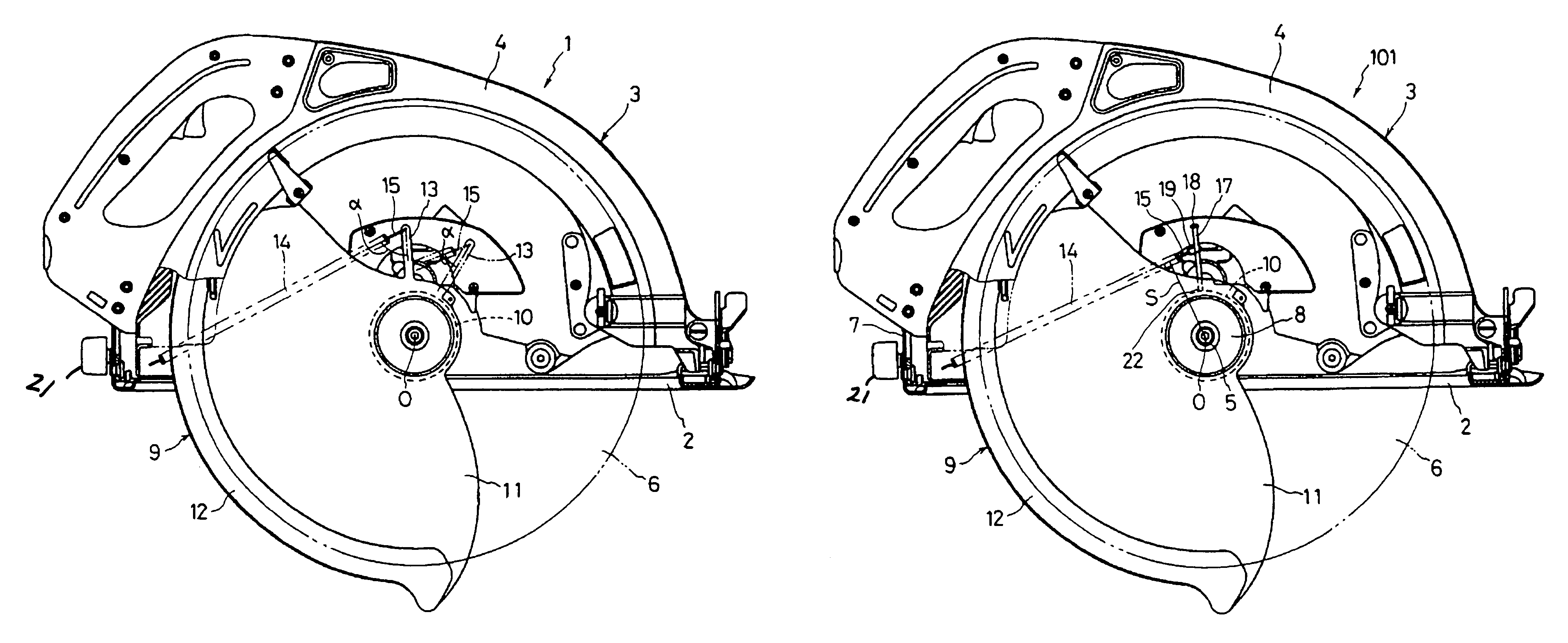Circular saw with an improved lower blade guard
a technology of circular saws and lower blade guards, which is applied in the field of circular saws, can solve the problems of reducing the utility of the blade, affecting the use of the blade, so as to achieve the effect of preventing inadvertent rotation of the lower blade guard and compromising the handling comfort of the saw
- Summary
- Abstract
- Description
- Claims
- Application Information
AI Technical Summary
Benefits of technology
Problems solved by technology
Method used
Image
Examples
first embodiment
[0031]FIG. 1 is a front elevation of a circular saw 1 according to the present invention. The circular saw 1 includes a generally rectangular and flat base plate 2 and a saw blade assembly 3 mounted on the base plate 2. The saw blade assembly 3 encases a motor (not shown) on its back side and includes an upper blade guard 4 secured to its front side. A spindle 5 transmitting the rotation of the motor is supported by a bearing box 8 coupled to the saw blade assembly 3, projecting from the motor into the space defined by the upper blade guard 4. A circular saw blade 6 is attached at right angles to the top end of the spindle 5 such that approximately half of the blade protrudes below the base plate 2. Furthermore, the right end (as viewed in FIGS. 1–3, i.e., the front end in relation to the direction in which cutting is to be made) of the upper blade guard 4 is hinged to a shaft (not shown) in such a manner as to allow the saw blade assembly 3 to pivot on the shaft. The opposite end o...
second embodiment
[0037]An alternate structure of the present invention is described hereinafter with reference to the attached drawings, in particular FIGS. 4–6, in which identical or similar reference numerals or characters denote identical or similar parts or elements throughout the several views. Therefore, description of such elements is omitted.
[0038]With specific reference to FIG. 4, a circular saw 101 of this embodiment replaces the connecting bar 13 with a connecting bolt or pin 17 which is secured to the sleeve portion 10 of the lower blade guard 9 at a base or bottom end 22 of the bolt and projects upper-rearward along a diametrical line passing through the axis of rotation of the guard 9. The connecting bolt 17 has a head 18 having a larger diameter than the rod portion so as to prevent a ring 19 (to be described in further detail below) attached to the connector 15 from slipping off the bolt 17. Furthermore, the connecting bolt 17 has the same length as the connecting bar 13 described in...
PUM
| Property | Measurement | Unit |
|---|---|---|
| angle | aaaaa | aaaaa |
| angle | aaaaa | aaaaa |
| axis of rotation | aaaaa | aaaaa |
Abstract
Description
Claims
Application Information
 Login to View More
Login to View More - R&D
- Intellectual Property
- Life Sciences
- Materials
- Tech Scout
- Unparalleled Data Quality
- Higher Quality Content
- 60% Fewer Hallucinations
Browse by: Latest US Patents, China's latest patents, Technical Efficacy Thesaurus, Application Domain, Technology Topic, Popular Technical Reports.
© 2025 PatSnap. All rights reserved.Legal|Privacy policy|Modern Slavery Act Transparency Statement|Sitemap|About US| Contact US: help@patsnap.com



